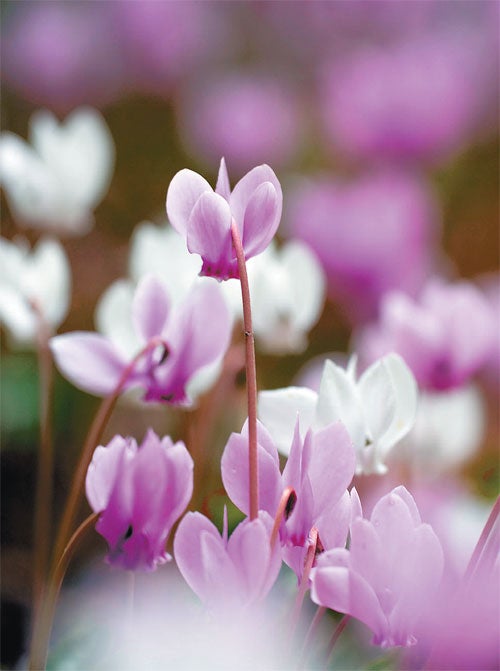Urban gardener, Cleve West: The cyclamen cycle

I'm not a fan of indoor plants but a recent gift of cyclamen is doing its best to soften me up. Ordinarily, I'd much rather see them outside. In a Somerset village recently, I stood captivated where a sprinkling of pink flowers sat jewel-like among the russet leaf fall of a large beech - echoing the natural habitat that woodland cyclamen enjoy in the wild. The marbled leaves also added sufficient darkness of tone to accentuate the beauty of the flowers.
Belonging to the same family as the primrose (Primulaceae), cyclamens carry a similar potency, albeit tinged with quiet acceptance rather than the hope that the primrose gives us for the approaching season. Within the genus (which is found from Europe to West Asia and North Africa), there are enough species to flower throughout the year, although most appear from autumn to spring in various habitats from coniferous and broadleaf forest to alpine meadows and rocky gullies (where free draining soil suits it best).
Cyclamen persicum (the florists' favourite) originated in south-western Turkey and will tolerate a wide range of habitats flowering through winter and spring. They are not sufficiently hardy to survive outside in the UK, although they can withstand temperatures as low as -2C as long as the leaves are kept dry. It pains me to write this but they are largely undemanding in terms of maintenance so the languishing specimen at home must have plundered reserves it didn't know it had to provide both flower and scent. We should repot ours during its dormant period (late July to early August). A touch of pine-needle litter added to a loam-based compost will keep it happy but making the soil too rich will result in too much sappy leaf growth and leave the plant vulnerable to mildew. We should water infrequently to imitate its natural habitat. Alpine varieties such as C. parviflorum, which are more used to meltwater, might resent this, but careful watering around the edge of the pot from above is generally fine so long as the tuber isn't left to sit under water. The plant can then survive for a while completely dry before its next soaking.
C. coum and C. hederifolium are two of the hardier varieties, if you're set on planting some outside. In the wild, cyclamens are often found in rock fissures and among the roots of trees, taking advantage of both shelter and the free draining nature of the soil, so it's worth bearing this in mind when selecting a spot in the garden. The protection of a tree canopy is ideal as, despite their hardiness, the leaves of the cyclamen blacken and go limp if exposed to frost. This is not as disastrous as it sounds and the foliage can recover provided the plants are protected from direct sunlight. Ideally, cyclamens need a position where they can be left undisturbed to self-seed and to colonise an area for dramatic impact.
Urbanites with small spaces will rarely be able to establish a large colony, but we are a frugal bunch and, quite often, one or two blooms is all we need to lift the spirits. A dryish corner in semi-shade might offer the necessary conditions - or underneath a shrub. Hardy varieties can be planted with their tops just under or at the soil surface. A grit covering will give some protection and remind you where they are. Less hardy species, such as the pale pink C. mirabile or deep-carmine C. trochopteranthum, should go deeper (twice as deep as the tuber is thick, as a rule of thumb).
Just inside the entrance to RHS Wisley, on a high retaining wall, a dusting of C. hederifolium allows rare intimacy with the plant at eye-level. This reminds me that the charm of potted cyclamens is that they too can be placed at a level where they can be scrutinised up close and even held above head height to see the propeller-shaped profile. But perhaps this is exactly why cyclamen in the wild are so exciting. If Nature has taught us anything, it's that a teasing peep of beauty will always be more beguiling.
Subscribe to Independent Premium to bookmark this article
Want to bookmark your favourite articles and stories to read or reference later? Start your Independent Premium subscription today.

Join our commenting forum
Join thought-provoking conversations, follow other Independent readers and see their replies